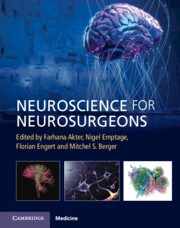Book contents
- Neuroscience for Neurosurgeons
- Neuroscience for Neurosurgeons
- Copyright page
- Contents
- Contributors
- Section 1 Basic and Computational Neuroscience
- Chapter 1 Neuroanatomy
- Chapter 2 Cerebral Autoregulation
- Chapter 3 Neuroimmune Interactions
- Chapter 4 Anatomy and Physiology of the Neuron
- Chapter 5 Synaptic Transmission
- Chapter 6 Sensory Pathways
- Chapter 7 Somatosensory and Somatic Motor Systems
- Chapter 8 Neuron Models
- Chapter 9 An Introduction to Artificial Intelligence and Machine Learning
- Chapter 10 Artificial Intelligence in Neuroscience
- Chapter 11 Probability and Statistics
- Section 2 Clinical Neurosurgical Diseases
- Index
- References
Chapter 4 - Anatomy and Physiology of the Neuron
from Section 1 - Basic and Computational Neuroscience
Published online by Cambridge University Press: 04 January 2024
- Neuroscience for Neurosurgeons
- Neuroscience for Neurosurgeons
- Copyright page
- Contents
- Contributors
- Section 1 Basic and Computational Neuroscience
- Chapter 1 Neuroanatomy
- Chapter 2 Cerebral Autoregulation
- Chapter 3 Neuroimmune Interactions
- Chapter 4 Anatomy and Physiology of the Neuron
- Chapter 5 Synaptic Transmission
- Chapter 6 Sensory Pathways
- Chapter 7 Somatosensory and Somatic Motor Systems
- Chapter 8 Neuron Models
- Chapter 9 An Introduction to Artificial Intelligence and Machine Learning
- Chapter 10 Artificial Intelligence in Neuroscience
- Chapter 11 Probability and Statistics
- Section 2 Clinical Neurosurgical Diseases
- Index
- References
Summary
We discuss the fundamental units of the nervous system: neurons and supporting cells, which are formed from radial glial cells, progenitor cells that divide to generate new neurons, which then migrate to their destination. An understanding of the anatomy of neurons and their function enables us to decipher how information travels within the nervous system and how neurons communicate with each other through synapses to form networks capable of performing sophisticated and complex tasks. We then discuss how ions traverse the cell membrane and the critical role ion channels play in establishing resting membrane potential, and how action potentials are generated and propagated along the axon.
- Type
- Chapter
- Information
- Neuroscience for Neurosurgeons , pp. 72 - 83Publisher: Cambridge University PressPrint publication year: 2024



